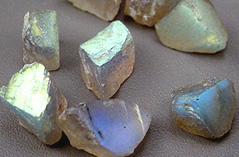
Feldspar is a ubiquitous mineral that, usually in the form of small grains, makes up 50-60% of the content of the rocks of the Earth's crust. More precisely, it's a group of related mineral species, which, in larger deposits of single crystal forms, are known as several familiar gemstones: amazonite, moonstone, sunstone, orthoclase and labradorite.
The entire feldspar group is divided into two main branches, the potassium feldspars: microcline and orthoclase, and the sodium/calcium feldspars known as the plagioclase "series". A solid solution series, in mineralogical terms, is a set of mineral species which grade in composition, within the same basic chemical formula, through mixtures, from one pure end material to the other. In the case of the plagioclase feldspars the series runs from 100% albite (NaAlSi3O8) to 100% anorthite (CaAl2Si2O8) with labradorite in the near 50/50 range.
Labradorite is translucent to opaque with light to dark grey body color, often with needle-like inclusions of black magnetite or ilmenite and usually showing some fracturing.
This gem is the only species that can claim sole possession of an entire optical phenomenon, in this case "Labradorescence". Only Labradorite gems show this distinctive directionally-oriented surface display of one or more metallic looking spectral colors. The structural cause is the repeated thin layer (lamellar) twinning of its crystals which creates both diffraction and interference as light passes through and reflects from the parallel surfaces.
One of the most singular aspects of this iridescence is its distinct directionality. Notice in the photo below, how certain faces show a silvery or blue "shiller" and the others do not. Any gem fashioned from this material must be carefully oriented so that this display shows to best advantage, and even then, it will be visible only at certain angles. The thickness and uniformity of the layers determines the color(s) to be seen.

The name derives from the original mine site along the coast of Labrador, found at the beginning of the 19th Century and which is still productive, but India, Scandinavia, Madagascar and the US now provide additional supplies. The majority of specimens of this gem show a silvery blue to bright blue sheen. The three specimens below show the range from semi-transparency, through translucence to opacity seen in the species. Lapidary artists have long exploited the beauty of the material in cabochons and gem carvings. Faceted specimens, though rarely seen, have a distinctive and unusual beauty.
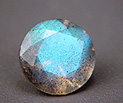
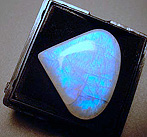
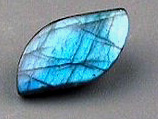
There are no synthetics or simulants to worry about with this gem group and enhancements are rarely encounted. One related issue does bear mentioning however--> large quantities of a translucent white Labradorite which originates in India is widely sold under the misnomer "rainbow moonstone" at very modest prices. (True moonstone is a different, rarer and considerably more expensive, species of feldspar that has its own distinctive optical phenomenon.) As you can see, the material in question is no less attractive for bearing its improper name.
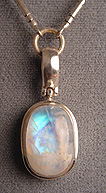
A particularly colorful deposit of Labradorite was discovered in Finland, and later mined elsewhere in Scandinavia, which shows not only blue, but green, gold and rarely red or violet sheen, and has been given its own variety name: "spectrolite", due to its resemblance to the color spectrum.
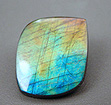
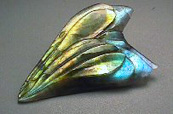
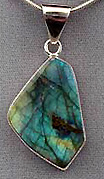

Due to its modest hardness (6 - 6.5), heat sensitivity, and cleavability this gem is relatively fragile and must be set, worn, and cleaned with care. That care will reward the owner many times over, however, as a high quality, well cut piece of labradorite or spectrolite is a joy to behold. Every movement creates a shifting pattern of surface colors, the brightest of which can rival those on the wings of tropical butterflies. Ultrasonic or steam cleaning is too risky and gems to be used in rings or bracelets should be given protective settings and worn infrequently. The best use for this gem is earrings, brooches and pendants which are worry free.
Labradorite is a gem bargain, as even the highest quality specimens are a fraction of the cost of comparably colored ammolites, precious opals or fire agates. The most valuable pieces of both labradorite and spectrolite are those with the brightest and most uniform color flashes, showing no "dead" areas. In premium gems the fracturing and inclusions are minimal and non-intrusive. Beyond that, the value of a piece lies in its size and in the artistry of the cutting or carving.